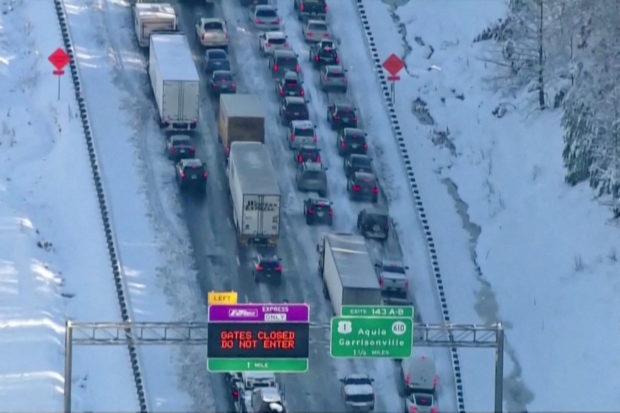Thousands of desperate drivers trapped on snowbound Virginia highway

Vehicles are seen in a still image from video as authorities worked to reopen an icy stretch of Interstate 95 closed after a storm blanketed the U.S. region in snow a day earlier, near Garrisonville, Virginia, U.S. January 4, 2022. ABC/WJLA via REUTERS
WASHINGTON — U.S. Senator Tim Kaine’s routine commute from his Virginia home to Washington on Monday turned into a 27-hour ordeal when a blizzard left a major highway south of the nation’s capital impassable, stranding him and thousands of other motorists without food and water in the freezing cold.
Interstate 95 — one of the busiest thoroughfares on the East Coast — was closed for hours in both directions near Fredricksburg, about 55 miles (89 km) south of Washington, after the region was blanketed by up to a foot (30 cm) of snow, the Virginia Department of Transportation said on Tuesday.
Traffic on the 47-mile (76-km) stretch of I-95 came to a standstill about 8 p.m. on Monday (0100 GMT on Tuesday) and did not begin moving again until Tuesday afternoon.
For hours overnight and well after daybreak, hundreds of tractor-trailer trucks and cars lined the snow-clogged roadway as their drivers grew increasingly desperate about their predicament and exasperated by what appeared to be a slow response by authorities.
Kaine, the 2016 Democratic nominee for vice president, was one of the many motorists caught up in the paralysis.
Article continues after this advertisement“I started my normal 2 hour drive to DC at 1pm yesterday,” he posted on Twitter on Tuesday morning. “19 hours later, I’m still not near the Capitol.”
Article continues after this advertisementThe senator finally arrived in Washington 27 hours after leaving Richmond, his communications director said. Kaine told CNN that he had had nothing to eat or drink since setting out on Monday.
Jim DeFede, an investigative reporter with CBS 4 Miami, found himself stuck somewhere in Prince George County.
“Good morning from I-95 in Virginia where I have been trapped in my car for more than 20 hours,” he tweeted just after dawn. “I’m not sure, but I think I now qualify for Virginia residency.”
DeFede later reported that fire and rescue teams had finally arrived early on Tuesday afternoon, guiding his car and other vehicles in reverse to a just-opened exit.
State and local emergency personnel worked through the morning and into the afternoon to clear downed trees, assist disabled vehicles and reroute drivers, Governor Ralph Northam said on Tuesday.
“It’s going to take some time to get to these folks. We’re trying to get water, trying to get to warming stations for them, so we’re doing everything we can to keep people safe and to get these roads cleared,” he said during a telephone briefing.
‘One step at a time’
Northam said he hoped to completely reopen the highway on Tuesday but “we kind of take it one step at a time.” He promised to provide frequent updates.
Northam and the Virginia Department of Transportation came under fierce criticism for the state’s response and failure to call in the National Guard. Some urged President Joe Biden to mobilize federal resources to rescue stranded drivers and reopen the highway.
“This is insane. Nothing is being done, 911 isn’t much help, neither is Virginia state police. And the state has yet to contact National Guard. Insane,” wrote one Twitter user who claimed to have been stuck on I-95 south for hours.
Northam told WTOP radio the National Guard was available, but said it had yet to be mobilized.
The U.S. Department of Transportation posted a Twitter message saying it was ready to help the state reopen the highway and assist motorists.
Volunteers were doing what they could to help.
“Reply with need and mile marker and we’ll try to connect you to other drivers in your area who might be able to share some supplies with you,” tweeted Reagan Battalion, a conservative political organization.
In another volunteer effort, someone passed out Schmidt Old Tyme bread after the company agreed to open one of its trucks stranded on the interstate, a local CBS reporter caught in the standstill said.
The heavy snow, which fell in parts of the Southeast and mid-Atlantic states, triggered crashes and spin-outs on I-95, paralyzing that section of the highway. The standstill persisted as temperatures dropped below freezing overnight.
The fast-moving storm forced the closure of federal offices and schools, grounded airplanes and knocked out electrical power for thousands of people.